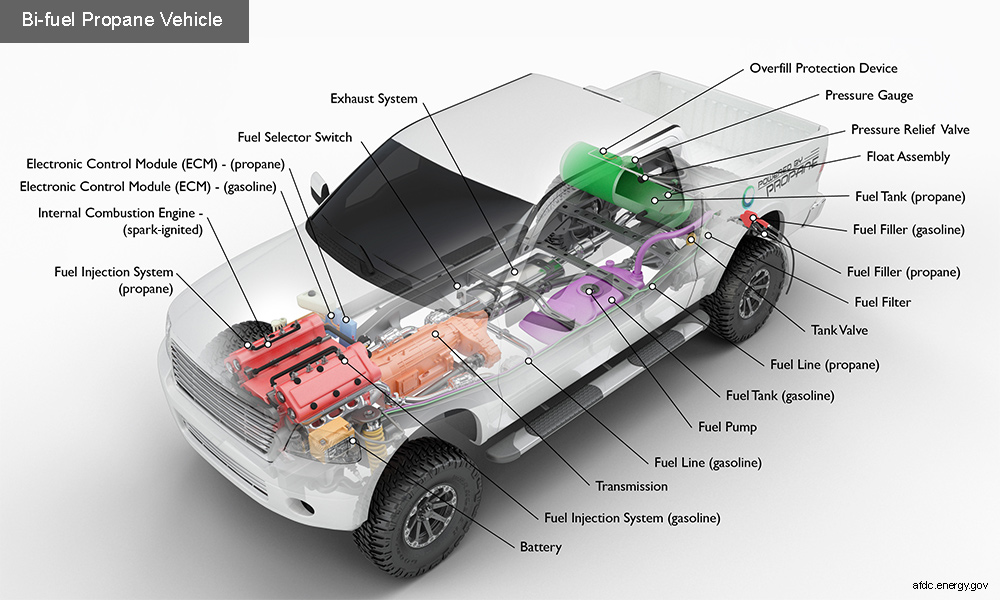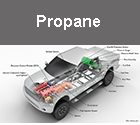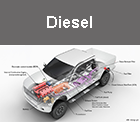How Do Bi-fuel Propane Vehicles Work?
Bi-fuel propane vehicles typically use a spark-ignited internal combustion engine. A bi-fuel propane vehicle can use either gasoline or propane in the same internal combustion engine. Both fuels are stored on board and the driver can switch between the fuels. The vehicle is equipped with fuel tanks, fuel injection systems, and fuel lines for both fuels. Learn more about propane vehicles.
High-res image
Key Components of a Bi-fuel Propane Vehicle
Battery: The battery provides electricity to start the engine and power vehicle electronics/accessories.
Electronic control module (ECM) - (gasoline): The ECM controls the gasoline mixture, ignition timing, and emissions system; monitors the operation of the vehicle; safeguards the engine from abuse; and detects and troubleshoots problems.
Electronic control module (ECM) - (propane): In a bi-fuel propane configuration, the propane ECM communicates with the gasoline ECM and controls the propane mixture, ignition timing, and emissions system; monitors the operation of the vehicle; safeguards the engine from abuse; and detects and troubleshoots problems.
Exhaust system: The exhaust system channels the exhaust gases from the engine out through the tailpipe. A three-way catalyst is designed to reduce engine-out emissions within the exhaust system.
Float assembly: The float assembly monitors the fuel level in a tank.
Fuel filler (gasoline): This is a filler or "nozzle" used to add gasoline to the tank.
Fuel filler (propane): This is a filler or "nozzle" used to add propane to the tank.
Fuel filter: This filter traps contaminants and other byproducts to prevent them from clogging critical fuel system components, such as fuel injectors.
Fuel injection system (gasoline): This system inserts gasoline into the engine's combustion chambers for ignition.
Fuel injection system (propane): This system inserts propane into the engine's combustion chambers for ignition.
Fuel line (gasoline): A metal tube or flexible hose (or a combination of these) allows for transferring gasoline from the tank to the engine's fuel injection system.
Fuel line (propane): A metal tube or flexible hose (or a combination of these) allows for transferring propane from the tank to the engine's fuel injection system.
Fuel pump: A pump that transfers fuel from the tank to the engine's fuel injection system via the fuel line.
Fuel selector switch: On bi-fuel vehicles, this dashboard switch allows the driver to select between fuels.
Fuel tank (gasoline): This tank stores gasoline on board the vehicle until it's needed by the engine.
Fuel tank (propane): This tank stores propane on board the vehicle until it's needed by the engine.
Internal combustion engine (spark-ignited): In this configuration, fuel is injected into either the intake manifold or the combustion chamber, where it is combined with air, and the air/fuel mixture is ignited by the spark from a spark plug.
Overfill protection device: This device shuts off the flow of fuel into a fuel tank after 80% capacity has been reached.
Pressure gauge: This gauge measures and displays the fuel pressure within the tank.
Pressure relief valve: This device incorporates a valve to limit the pressure within the fuel tank. If the tank exceeds a preset pressure level, the valve opens and fuel is vented from the tank.
Tank valve: This primary, manual valve stops fuel from entering or leaving the tank.
Transmission: The transmission transfers mechanical power from the engine and/or electric traction motor to drive the wheels.



